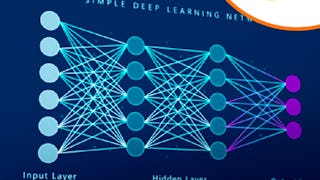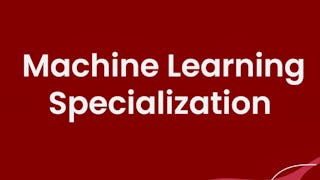This course addresses the challenge of machine learning (ML) in the context of small datasets, a significant issue due to ML's increasing data demands. Despite ML's success in various fields, many areas can't provide large labeled datasets because of costs, privacy, or security laws. As big data becomes standard, efficiently learning from smaller datasets is crucial. This course, ideal for graduate students with some ML experience, focuses on modern deep learning techniques for small data applications relevant in healthcare, military, and various industry sectors. Prerequisites include ML familiarity and Python proficiency. Deep learning experience is not necessary but beneficial.



Skills you'll gain
Details to know

Add to your LinkedIn profile
June 2025
8 assignments
See how employees at top companies are mastering in-demand skills

There are 7 modules in this course
In this module, we will explore the pivotal role of data as the foundation for machine learning algorithms. We begin by discussing the significance of large datasets in training deep learning models as these datasets are crucial for the models’ successful application and effectiveness. We will also delve into the challenges associated with small datasets, particularly in sensitive fields such as healthcare and defense, where data acquisition is often difficult, costly, or subject to stringent privacy and security regulations. To address these challenges, the course will introduce various strategies for making the most of limited data, including data-efficient machine learning techniques and the use of synthetic data augmentation. Additionally, we will present the course structure and discuss a curated selection of research papers that align with and enrich our course topics.
What's included
2 videos13 readings1 assignment
In this module, we will delve into the core aspects of machine learning with a focus on the importance of data, particularly in deep learning applications. We start by emphasizing how large datasets are essential for training deep learning models effectively, as they enable the models to capture and learn from complex patterns, improving their overall performance. Additionally, we'll explore the intersection of data availability, computational power, and model capacity, highlighting how these elements interact to refine model accuracy and efficiency. Furthermore, the module will cover computing advancements beyond Moore's Law and their impact on machine learning, illustrating how modern hardware like CPUs, GPUs, and TPUs enhance computational capabilities critical for training sophisticated models. We'll also delve into scaling laws in deep learning, discussing empirical findings that show how model performance improves predictably with increases in dataset size and model complexity, although with diminishing returns. To provide a deeper theoretical foundation, we'll examine the Vapnik-Chervonenkis (VC) theory, which offers insights into how learning curves and model complexity relate to a model’s ability to generalize from training data. This discussion will extend to practical applications and theoretical limitations, helping to frame machine learning challenges in terms of data sufficiency, model fitting, and the balance between bias and variance. By the end of this module, students will have a thorough understanding of the dynamic interplay between these factors and their implications for machine learning practice and research.
What's included
1 video19 readings2 assignments1 app item
In this module, we’ll explore transfer learning and its role in data-efficient machine learning, where models leverage knowledge from previous tasks to improve performance on new, related tasks. We’ll also cover various types of transfer learning, including transductive, inductive, and unsupervised methods, each addressing different challenges and applications. We’ll discuss some practical steps for implementing transfer learning, such as selecting and fine-tuning pre-trained models, to reduce reliance on large datasets. We’ll also examine data-driven and physics-based simulations for data augmentation, highlighting their use in enhancing training under constrained conditions. Finally, we’ll review key papers on transfer learning techniques to address data scarcity and improve model performance.
What's included
1 video15 readings1 assignment
In this module, you'll explore the concept of domain adaptation, a key aspect of transductive transfer learning. Domain adaptation helps you train models that perform well on a target domain, even when its data distribution differs from the source domain. You'll learn about the challenges of domain shift and labeled data scarcity and how these can impact model performance. We'll cover different types of domain adaptation, including unsupervised, semi-supervised, and supervised approaches. You'll also dive into techniques like Deep Domain Confusion (DDC), which integrates domain confusion loss into neural networks to create domain-invariant features. Additionally, you'll discover advanced methods such as Domain-Adversarial Neural Networks (DANNs), Correlation Alignment (CORAL), and Deep Adaptation Networks (DANs) that build on DDC to enhance domain adaptation by aligning feature distributions and capturing complex dependencies across network layers.
What's included
1 video10 readings1 assignment
In this module, we’ll explore weak supervision, a technique for training machine learning models with limited, noisy, or imprecise labels. You'll learn about different types of weak supervision and why they are crucial in small data domains. We’ll cover techniques such as semi-supervised learning, self-supervised learning, and active learning, along with advanced methods such as Temporal Ensembling and the Mean Teacher approach. Additionally, you'll discover Bayesian deep learning and active learning strategies to improve training efficiency. Finally, you'll see real-world applications in fields like medical imaging, NLP, fraud detection, autonomous driving, and biology.
What's included
1 video8 readings1 assignment
In this module, you'll explore how Zero-Shot Learning (ZSL) enables models to recognize new categories without having seen any examples of those categories during training. This is achieved by leveraging intermediate semantic descriptions, such as attributes, shared between seen and unseen classes. You'll also learn about the importance of regularization in preventing overfitting and improving generalization, as well as how generative models like GANs and VAEs enhance ZSL by synthesizing unseen class data. Additionally, we'll examine Generalized Zero-Shot Learning (GZSL), which tests models on both seen and unseen classes, making the task more challenging and realistic. By the end of this module, you'll have a solid understanding of how ZSL and its extensions can be applied to various machine learning tasks.
What's included
1 video9 readings1 assignment
This module focuses on Few-Shot Learning (FSL), a critical paradigm in machine learning that enables models to classify new examples with only a small number of labeled instances. Unlike traditional deep learning models that require vast amounts of labeled data, FSL mimics the human ability to generalize from limited examples, making it highly useful for tasks like image classification, object detection, and natural language processing (NLP). The lecture introduces Matching Networks, a metric-based learning approach designed to solve one-shot learning problems by learning a similarity function that maps new examples to previously seen labeled instances. Students will gain an in-depth understanding of how nearest-neighbor approaches, differentiable embedding functions, and attention mechanisms help in optimizing few-shot learning models. Through discussions, theoretical formulations, and real-world applications, this lecture equips students with practical insights into how AI can function effectively in data-scarce environments.
What's included
1 video7 readings1 assignment
Earn a career certificate
Add this credential to your LinkedIn profile, resume, or CV. Share it on social media and in your performance review.
Instructor

Offered by
Explore more from Machine Learning
 Status: Free
Status: FreeAmazon Web Services
 Status: Free Trial
Status: Free Trial Status: Free Trial
Status: Free TrialDeepLearning.AI
 Status: Free Trial
Status: Free TrialUniversity of Washington
Why people choose Coursera for their career





Open new doors with Coursera Plus
Unlimited access to 10,000+ world-class courses, hands-on projects, and job-ready certificate programs - all included in your subscription
Advance your career with an online degree
Earn a degree from world-class universities - 100% online
Join over 3,400 global companies that choose Coursera for Business
Upskill your employees to excel in the digital economy
Frequently asked questions
Access to lectures and assignments depends on your type of enrollment. If you take a course in audit mode, you will be able to see most course materials for free. To access graded assignments and to earn a Certificate, you will need to purchase the Certificate experience, during or after your audit. If you don't see the audit option:
The course may not offer an audit option. You can try a Free Trial instead, or apply for Financial Aid.
The course may offer 'Full Course, No Certificate' instead. This option lets you see all course materials, submit required assessments, and get a final grade. This also means that you will not be able to purchase a Certificate experience.
When you purchase a Certificate you get access to all course materials, including graded assignments. Upon completing the course, your electronic Certificate will be added to your Accomplishments page - from there, you can print your Certificate or add it to your LinkedIn profile. If you only want to read and view the course content, you can audit the course for free.
You will be eligible for a full refund until two weeks after your payment date, or (for courses that have just launched) until two weeks after the first session of the course begins, whichever is later. You cannot receive a refund once you’ve earned a Course Certificate, even if you complete the course within the two-week refund period. See our full refund policy.
More questions
Financial aid available,


